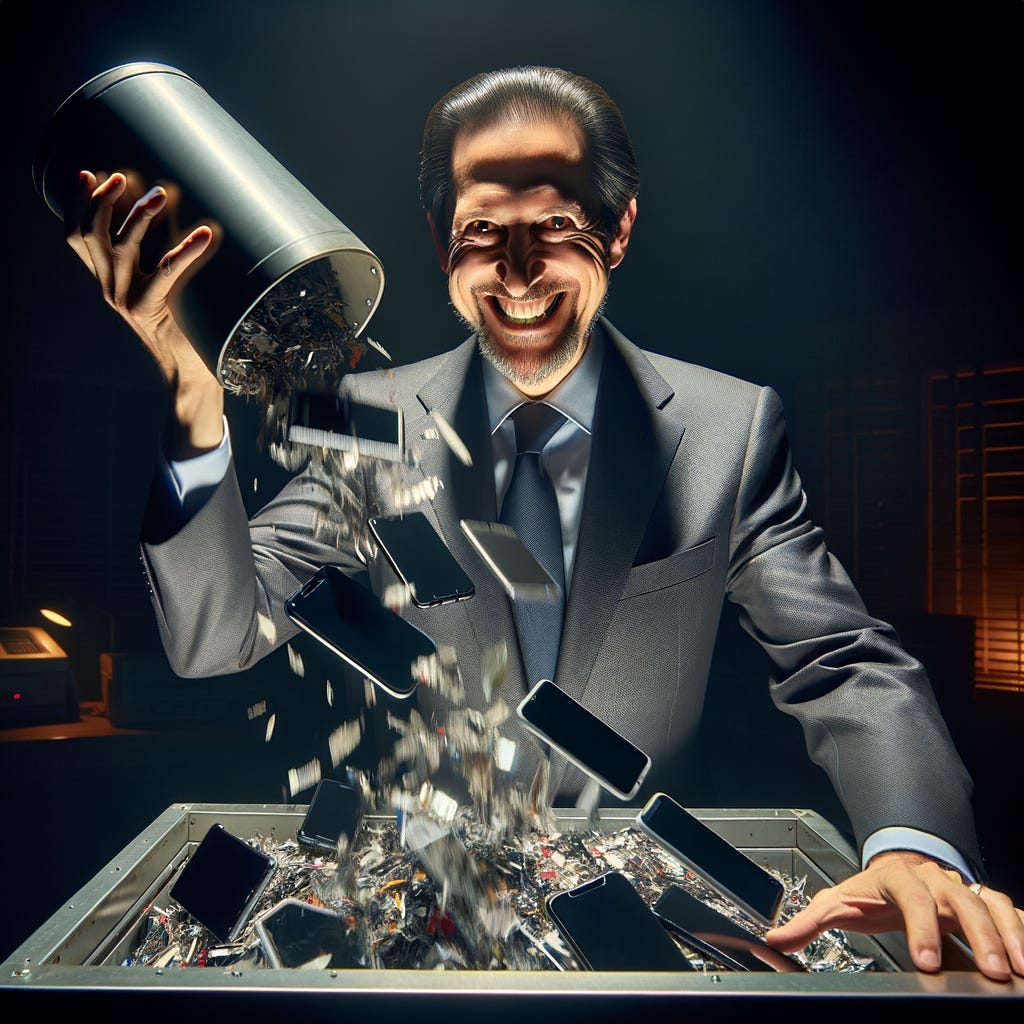Apple’s Dirty Recycling Secrets; Too Much Solar Power?!; Carbon-Free Mining
Issue #6 of the newsletter about how the raw materials we need for renewable energy and digital technology are hurting people and the planet—and how we can do better.
Apple’s Dirty Recycling Secrets
Apple loves to brag that it is “committed to protecting the planet,” but it’s more committed to protecting profits—even if that means shredding used iPhones and other gear that could easily be refurbished and reused. Austin Carr reports in Bloomberg Businessweek that in the late 2010s, under the auspices of its recycling program, Apple shipped hundreds of thousands of used iPhones, iPads and Apple Watches—gadgets disposed of at its stores, or obtained from customers trading up to newer models—to an e-waste processing company in Ontario called GEEP Canada Inc. GEEP was explicitly required to smash every single gadget to pieces so the metals they contained could be recycled, even if the machines were still in good condition. But an Apple audit found that nearly 100,000 of those gadgets weren’t shredded, but apparently resold: “Cellular and other device identifiers revealed iPhones that should have been crunched into croutons were instead reactivated by new users in China,” writes Carr. Apple sued GEEP in 2020 for $22.6 million, accusing it of allowing employees to steal used devices which they would repair and resell.
That lawsuit (still officially pending though GEEP has since been bought by another company) “implied that Apple was forcing a recycling partner to shred tens of thousands of iPhones that were apparently in prime condition for refurbishment,” writes Carr. Why would the company do that? “The shredding, critics said…was likely a way to keep cheaper used hardware from interfering with sales of new products.”
That makes perfect sense from an economic standpoint, but none at all from an environmental one. Recycling just about any product is easier on the planet than manufacturing a new one from virgin materials, but it still requires lots of energy, generates pollution, and is often performed by some of the poorest people on the planet. That goes double for digital devices, which are made with dozens of different metals and other materials, all of which need to be painstakingly separated out, purified and melted down before they can be recycled into a new product. Reusing devices is a much cheaper and cleaner way to go. Apple does refurbish and resell some devices, but only ones that are in pristine condition. After all, they make their money selling new gadgets, not by making it easy for customers to reuse old ones.
Too Much Solar Power?!
Seems you can have too much of a good thing—especially if you’re not prepared for it. California has installed so many solar power sources in recent years, from desert mega-installations to panels on people’s houses, that sometimes the state can’t even use it all. Gigawatts of power are simply being wasted, reports Shannon Osaka in The Washington Post.
The issue is that electricity demand tends to surge in the mornings and evenings, when folks are at home, and drops during the day when they’re at work or school. But solar arrays crank out the most power during the day, when the sun is strongest. That creates a daytime glut that drives prices below zero; rather than give away free energy, grid operators shut off the solar. California is further responding to the oversupply by cutting back on subsidies for rooftop solar. The pace of new installations is expected to slow.
This strikes me as exactly the wrong response. Whatever the vicissitudes of California’s energy market, the state, the country, and the world all need more renewable energy. As much as we can get, as fast as we can get it. If there’s more solar power than can be used at a given time in one particularly sunny part of America, the smart move is to invest in large-scale batteries to store that power for later, and to build more transmission lines to carry it to places that need it. In fact, a new study, recapped in Inside Climate News, found that a quartet of western US states could reap tens of billions of dollars by selling wind and solar power to other states—but only if the transmission infrastructure is expanded to carry all that energy.
That’s a reminder that the transition to renewable energy requires much more than just building solar panels and wind turbines and electric cars. It’s also going to require enormous amounts of infrastructure—industrial-sized batteries, power cables, car charging stations and on and on. And all of that, of course, requires lots and lots of metals.
How We Can Do Better: Carbon-Free Mining in Brazil
It’s not surprising to hear a California-based, consumer-dependent company like Apple bleating piously about sustainability. It’s another thing when a major industrial miner not only talks the talk but starts walking the walk. Vale, one of the world’s biggest (and most notorious) mining companies, says all of its operations in its home country of Brazil are now powered by renewable sources, including hydroelectric, wind and solar. The company has been working toward this goal since the 1990s, and made it over the line when it brought a new, $590 million solar plant online recently.
Not that Vale is some environmental hero. Worldwide, the company’s operations still emit millions of tons of carbon dioxide every year. Outside of the industry, it is probably best known for the catastrophic collapse of one of its waste dams in 2017, which killed some 270 people. But it deserves qualified kudos for making moves in the right direction. Hey, Vale even repurposes leftover sand from iron production to replace sand dug up from rivers and beaches! And if you don’t already know how important sand is to all our lives and the problems that come with it, have I got a book for you!






